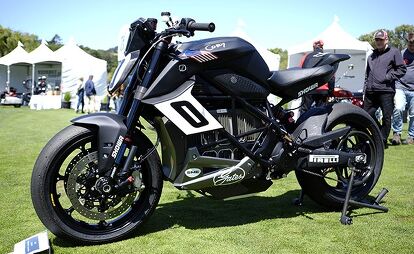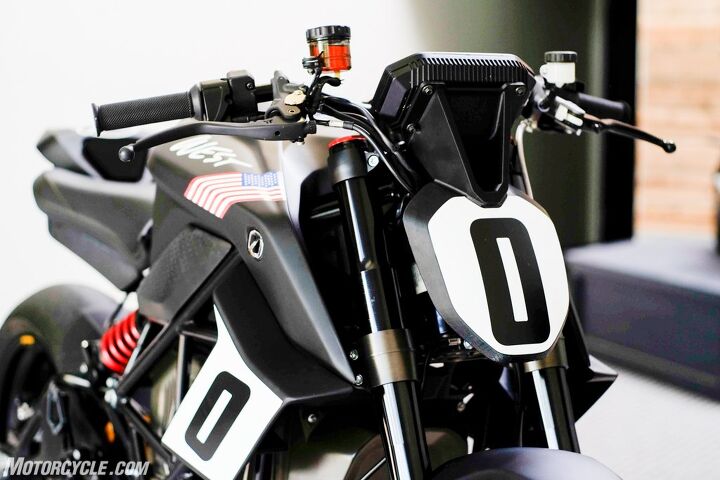Taking the Zero SR/F From Production Bike To Pikes Peak Racer In 8 Easy Steps

An in-depth look at the Zero SR/F that will tackle the 2019 Pikes Peak International Hill Climb
On the last Sunday in June, the famed Pikes Peak International Hill Climb will commence its 97th running. Taking to the mountain for the first time will be an official entry from Zero Motorcycles (not to be confused with my attempt in 2013 with a dealer-run effort with support from the factory) with its much acclaimed SR/F – a bike which, judging by the 424 comments (and counting) received on Evans’ Exclusive First Ride piece – is of interest to many people. Piloting the SR/F this year is Cory West, a very accomplished racer in his own right, and though he will be a Pikes Peak rookie, he’ll still be someone to look out for.
Of course, like any other motorcycle, getting the SR/F ready for competition duty requires some prep work. But getting it ready for battle is surprisingly simple compared to a traditional internal combustion motorcycle. Here are the 8 changes to turn a stock SR/F into a Pikes Peak racer – and four things that stayed the same.
Subframe
Like most other production motorcycles, the subframe is engineered to be strong enough to support the weight of a passenger and/or luggage. For cost purposes, it’s usually made from mild steel, too. Sure it’s strong and cheap, but it’s of no use on a race bike with nobody sitting on the back. The Pikes Peak SR/F features a custom chromoly steel tail section which serves a couple purposes: First, it shaves off a little weight compared to the stocker. Second, at the request of West, it slightly changes the ergos by raising the seat height a little – 20mm to be exact.
Bodywork
One of the first things to go when converting a street bike to race duty is the bodywork, and the SR/F is no different. Gone are the injection molded plastic pieces, replaced with a composite tank and composite reinforced, rapid prototype, 3D printed numberplates across the side and headlight location. These also shave off a little weight and satisfy the number plate requirement stated in the rules. Oh, and they look cool, too.
Chargers
The standard SR/F carries its 3, 6, 9, or 12KW charger on-board, since its primarily a street bike after all, and you’ve gotta have a charger wherever you go. The downside here is the weight penalty it brings – not as huge a concern on the street, but a big one for a race bike. For the Pikes Peak bike, Zero uses the 9KW charger, but since charging will be done in the same location every day, the charger was taken off the bike to save weight.
Wheels and Tires
In the quest to save weight (see a theme here?), the stock cast aluminum wheels are the next thing to go. In its place are a set of Dymag forged aluminum wheels, adding both strength and lightness. Wrapped around those wheels are Pirelli Superbike slicks in place of the stock Diablo Rosso III rubber (the reasoning should be obvious). Front tire size stays the same at 120/70-17, but the 180/55-17 Rosso III gets ditched in favor of a 180/60-17 rear slick. The taller overall tire brings plenty of advantages, not least of which is more rear ride height and taller gearing for a slightly higher top speed. Also, the taller tire changes the overall profile, bringing a handling change most riders, including West, prefer.
Brake Lever
If you look really closely, you might see what looks like a clutch lever. It’s not of course – it’s a rear brake lever. West really likes the modulation and control it provides him, especially in right turns at high lean angles.
Firmware
The standard SR/F uses Bosch’s Advanced MSC, or Motorcycle Stability Control with proprietary software Zero calls Cypher III. The “brains” of the motorcycle, the programming here is clearly very important. For the Pikes Peak build, Zero’s team of programmers tweaked the secret sauce with an aim towards performance. Exactly what was changed is a closely-held secret they preferred not to share with me, as you could imagine. If I were to make a guess, I’d hypothesize, at the very least, a higher thermal limit threshold to allow West to use more of the motorcycle’s performance for longer.
Suspension
Showa is one of Zero’s technical partners, providing the standard SR/F with its 43mm Big Piston Separate Function fork and 40mm adjustable shock units. But for Pikes Peak Zero and Showa went big. Like, MotoGP and World Superbike big. Up front is the same Showa BFF (Balance Free front Fork) gas charged fork and BRFC-lite (Balance Free Rear Cushion-lite) shock the factory Kawasaki WSBK team uses. Without getting into too much detail, the hydraulic circuits in both pieces minimize pressure balance fluctuations that are common in standard production units. The end result is better feel, a more composed chassis, and more stability under braking. All things you want when you’re going fast up a mountain.
Handlebars
Racers are all about feel, and being over the front tire as much as possible helps give the rider a sense of what the front contact patch is doing. In the case of the SR/F, the stock bar gets replaced by the MA010 piece from Rizoma. It has a lower rise than the stocker, putting Cory in a slightly more racy riding position and allowing him to put a little more weight over the front.
What’s the same
Battery
So what’s left of the standard SR/F production bike? For starters, the stock ZF14.4 lithium-ion battery remains. It’s more than enough to get Cory up and down the mountain, plus one of the goals with this project is to push the limits of the standard battery
Motor
Like the battery, the ZF75-10 Internal Permanent Magnet AC motor remains the same from the production machine. The goal, of course, is so Zero engineers can see just how far they can push the stock battery/motor combination. As a refresher, the peak torque is rated at 140 lb-ft and peak horsepower is rated at 110.
Chassis
While the stock subframe gets tossed for a custom unit, the standard steel trellis frame remains in tact to hold the battery in place.
Brakes
Believe it or not, the Pikes Peak SR/F uses the same brakes as the standard bike, meaning two 320mm discs and four-piston, radial-mount J.Juan calipers in front. A 240mm disc and single-piston J.Juan caliper sits out back.
The Result
A bike that weighs approximately 435 lbs – roughly 50 lbs lighter than stock – with relatively basic modifications. Combine that with the 110hp/140 lb-ft the standard motor puts out and you have a bike that should be fairly quick up the mountain. It definitely won’t be the fastest motorcycle, but it surely won’t be an embarassment.

Troy's been riding motorcycles and writing about them since 2006, getting his start at Rider Magazine. From there, he moved to Sport Rider Magazine before finally landing at Motorcycle.com in 2011. A lifelong gearhead who didn't fully immerse himself in motorcycles until his teenage years, Troy's interests have always been in technology, performance, and going fast. Naturally, racing was the perfect avenue to combine all three. Troy has been racing nearly as long as he's been riding and has competed at the AMA national level. He's also won multiple club races throughout the country, culminating in a Utah Sport Bike Association championship in 2011. He has been invited as a guest instructor for the Yamaha Champions Riding School, and when he's not out riding, he's either wrenching on bikes or watching MotoGP.
More by Troy Siahaan























































Comments
Join the conversation
If Zero is smart, these bodywork pieces will be in the accessory catalog next year.
Nice write-up, Troy. Very excited to see Cory's results this year at the PPIHC. I had the pleasure of being instructed by Cory at the Texas Tornado Boot Camp, along with Joe Prussiano, who is a 3 time PPIHC class winner. Amazing crew of folks there!